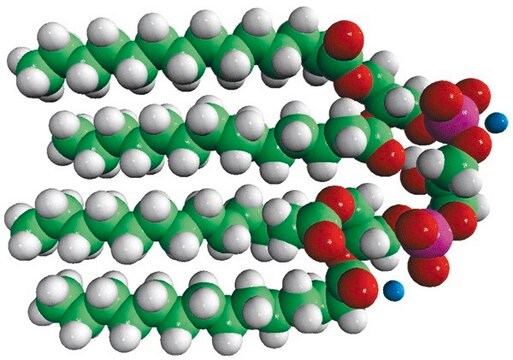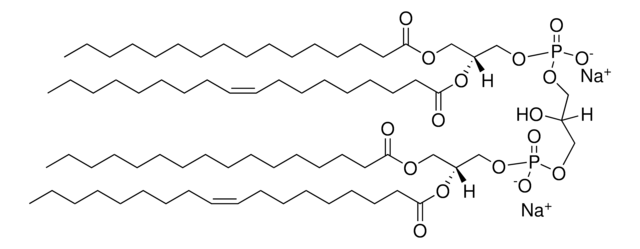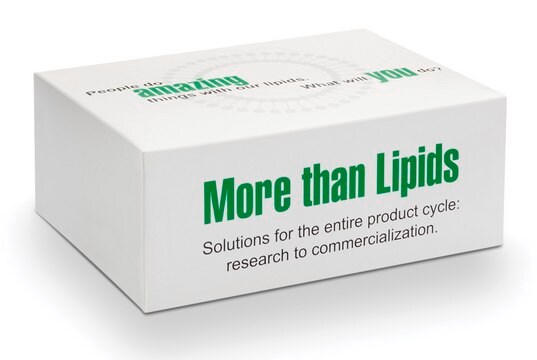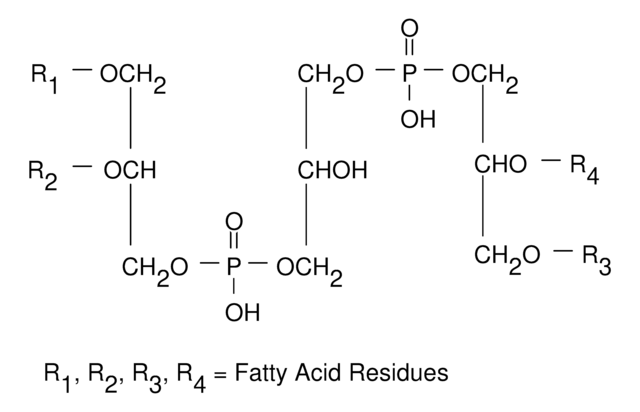Kluczowe dokumenty
710332C
Avanti
14:0 Cardiolipin (ammonium salt)
1′,3′-bis[1,2-dimyristoyl-sn-glycero-3-phospho]-glycerol (ammonium salt), chloroform
Synonim(y):
1,1′,2,2′-tetramyristoyl cardiolipin (ammonium salt); 1,1′,2,2′-tetratetradecanoyl cardiolipin (ammonium salt); CL(1′-[14:0/14:0],3′-[14:0/14:0])
About This Item
Polecane produkty
Próba
>99% (TLC)
Formularz
solution
opakowanie
pkg of 1 × 2.5 mL (710332C-25mg)
producent / nazwa handlowa
Avanti Research™ - A Croda Brand 710332C
stężenie
10 mg/mL (710332C-25mg)
typ lipidu
phospholipids
cardiolipins
Warunki transportu
dry ice
temp. przechowywania
−20°C
Opis ogólny
Zastosowanie
- as a standard in tandem mass spectrometry
- in the preparation of membrane proximal region (MPR) of human immunodeficiency virus (HIV-1) glycoprotein 41 (gp41)-lipopeptide conjugate and liposomes
- as a component of micelle for suspending C8 ceramide substrate in ceramide kinase assay
Działania biochem./fizjol.
Opakowanie
Informacje prawne
Hasło ostrzegawcze
Danger
Zwroty wskazujące rodzaj zagrożenia
Zwroty wskazujące środki ostrożności
Klasyfikacja zagrożeń
Acute Tox. 3 Inhalation - Acute Tox. 4 Oral - Aquatic Chronic 3 - Carc. 2 - Eye Irrit. 2 - Repr. 2 - Skin Irrit. 2 - STOT RE 1 - STOT SE 3
Organy docelowe
Central nervous system, Liver,Kidney
Klasa zagrożenia wodnego (WGK)
WGK 3
Wykazy regulacyjne
Wykazy regulacyjne dotyczą głównie produktów chemicznych. Można w nich podawać ograniczoną liczbę informacji na temat produktów niechemicznych. Brak wpisu oznacza, że żaden ze składników nie znajduje się w wykazie. Użytkownik odpowiada za zagwarantowanie bezpiecznego i zgodnego z prawem stosowania produktu.
EU REACH Annex XVII (Restriction List)
Wybierz jedną z najnowszych wersji:
Certyfikaty analizy (CoA)
It looks like we've run into a problem, but you can still download Certificates of Analysis from our Dokumenty section.
Proszę o kontakt, jeśli potrzebna jest pomoc Obsługa Klienta
Masz już ten produkt?
Dokumenty związane z niedawno zakupionymi produktami zostały zamieszczone w Bibliotece dokumentów.
Klienci oglądali również te produkty
Nasz zespół naukowców ma doświadczenie we wszystkich obszarach badań, w tym w naukach przyrodniczych, materiałoznawstwie, syntezie chemicznej, chromatografii, analityce i wielu innych dziedzinach.
Skontaktuj się z zespołem ds. pomocy technicznej

![14:0 Cardiolipin (sodium salt) 1′,3′-bis[1,2-dimyristoyl-sn-glycero-3-phospho]-glycerol (sodium salt), chloroform](/deepweb/assets/sigmaaldrich/product/images/390/523/992bed4e-3608-4209-aa6e-fa9206a4a31b/640/992bed4e-3608-4209-aa6e-fa9206a4a31b.jpg)









